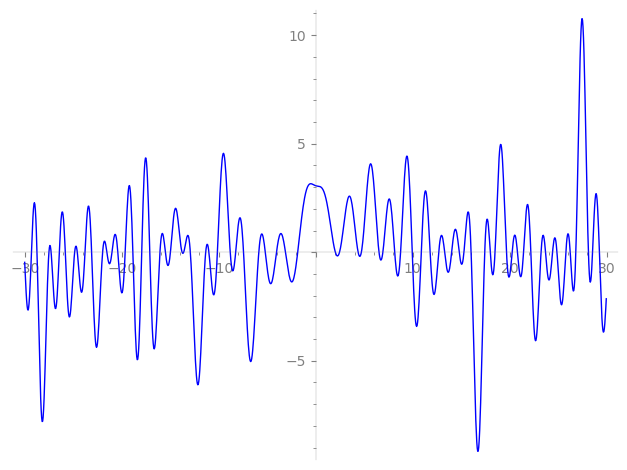| L(s) = 1 | + 2-s + (1.48 + 0.887i)3-s + 4-s + (0.511 − 0.295i)5-s + (1.48 + 0.887i)6-s + (2.62 − 0.304i)7-s + 8-s + (1.42 + 2.64i)9-s + (0.511 − 0.295i)10-s + (−3.05 − 5.29i)11-s + (1.48 + 0.887i)12-s + (1.86 − 3.08i)13-s + (2.62 − 0.304i)14-s + (1.02 + 0.0146i)15-s + 16-s − 7.64·17-s + ⋯ |
| L(s) = 1 | + 0.707·2-s + (0.858 + 0.512i)3-s + 0.5·4-s + (0.228 − 0.131i)5-s + (0.607 + 0.362i)6-s + (0.993 − 0.115i)7-s + 0.353·8-s + (0.474 + 0.880i)9-s + (0.161 − 0.0933i)10-s + (−0.921 − 1.59i)11-s + (0.429 + 0.256i)12-s + (0.518 − 0.855i)13-s + (0.702 − 0.0814i)14-s + (0.263 + 0.00378i)15-s + 0.250·16-s − 1.85·17-s + ⋯ |
\[\begin{aligned}\Lambda(s)=\mathstrut & 546 ^{s/2} \, \Gamma_{\C}(s) \, L(s)\cr =\mathstrut & (0.976 - 0.217i)\, \overline{\Lambda}(2-s) \end{aligned}\]
\[\begin{aligned}\Lambda(s)=\mathstrut & 546 ^{s/2} \, \Gamma_{\C}(s+1/2) \, L(s)\cr =\mathstrut & (0.976 - 0.217i)\, \overline{\Lambda}(1-s) \end{aligned}\]
Particular Values
| \(L(1)\) |
\(\approx\) |
\(3.04372 + 0.335332i\) |
| \(L(\frac12)\) |
\(\approx\) |
\(3.04372 + 0.335332i\) |
| \(L(\frac{3}{2})\) |
|
not available |
| \(L(1)\) |
|
not available |
\(L(s) = \displaystyle \prod_{p} F_p(p^{-s})^{-1} \)
| $p$ | $F_p(T)$ |
|---|
| bad | 2 | \( 1 - T \) |
| 3 | \( 1 + (-1.48 - 0.887i)T \) |
| 7 | \( 1 + (-2.62 + 0.304i)T \) |
| 13 | \( 1 + (-1.86 + 3.08i)T \) |
| good | 5 | \( 1 + (-0.511 + 0.295i)T + (2.5 - 4.33i)T^{2} \) |
| 11 | \( 1 + (3.05 + 5.29i)T + (-5.5 + 9.52i)T^{2} \) |
| 17 | \( 1 + 7.64T + 17T^{2} \) |
| 19 | \( 1 + (1.97 - 3.42i)T + (-9.5 - 16.4i)T^{2} \) |
| 23 | \( 1 - 8.38iT - 23T^{2} \) |
| 29 | \( 1 + (-1.39 - 0.803i)T + (14.5 + 25.1i)T^{2} \) |
| 31 | \( 1 + (-1.38 + 2.40i)T + (-15.5 - 26.8i)T^{2} \) |
| 37 | \( 1 + 2.22iT - 37T^{2} \) |
| 41 | \( 1 + (1.36 + 0.787i)T + (20.5 + 35.5i)T^{2} \) |
| 43 | \( 1 + (2.90 + 5.03i)T + (-21.5 + 37.2i)T^{2} \) |
| 47 | \( 1 + (4.94 - 2.85i)T + (23.5 - 40.7i)T^{2} \) |
| 53 | \( 1 + (-3.30 - 1.90i)T + (26.5 + 45.8i)T^{2} \) |
| 59 | \( 1 - 4.48iT - 59T^{2} \) |
| 61 | \( 1 + (-0.0871 - 0.0502i)T + (30.5 + 52.8i)T^{2} \) |
| 67 | \( 1 + (-8.95 + 5.17i)T + (33.5 - 58.0i)T^{2} \) |
| 71 | \( 1 + (0.875 + 1.51i)T + (-35.5 + 61.4i)T^{2} \) |
| 73 | \( 1 + (5.41 - 9.37i)T + (-36.5 - 63.2i)T^{2} \) |
| 79 | \( 1 + (3.17 + 5.50i)T + (-39.5 + 68.4i)T^{2} \) |
| 83 | \( 1 + 9.07iT - 83T^{2} \) |
| 89 | \( 1 - 4.11iT - 89T^{2} \) |
| 97 | \( 1 + (2.82 + 4.89i)T + (-48.5 + 84.0i)T^{2} \) |
| show more | |
| show less | |
\(L(s) = \displaystyle\prod_p \ \prod_{j=1}^{2} (1 - \alpha_{j,p}\, p^{-s})^{-1}\)
Imaginary part of the first few zeros on the critical line
−11.01294434524675559751928261341, −10.13544411589364566614606699729, −8.813570500858441250730885306230, −8.251624777926774769330648172885, −7.44097720301113382443820273901, −5.86713575207639854503634713387, −5.19887178148913703042781610353, −4.04308683969241630344104618355, −3.12108577975253776890026319971, −1.85653982554389920911378911486,
2.02320132542381051034239099631, 2.45113121666933395101025526692, 4.37164756892152480057530349498, 4.70436182455885642628857521687, 6.52430059057219440542836639017, 6.92064178610237882247402754368, 8.139248939973953517791329633744, 8.748017752245325578183299229779, 9.946215142971221559024262365563, 10.87894061597859156164649179940

